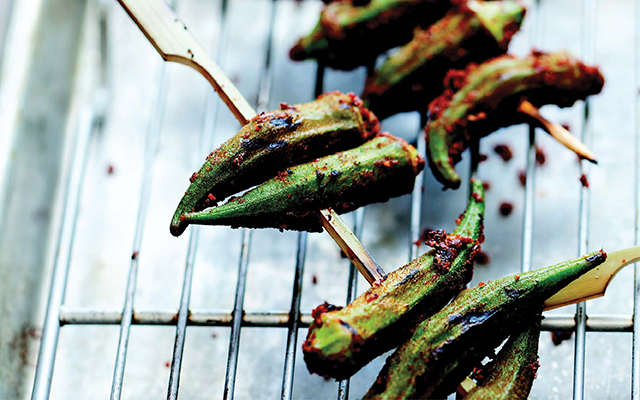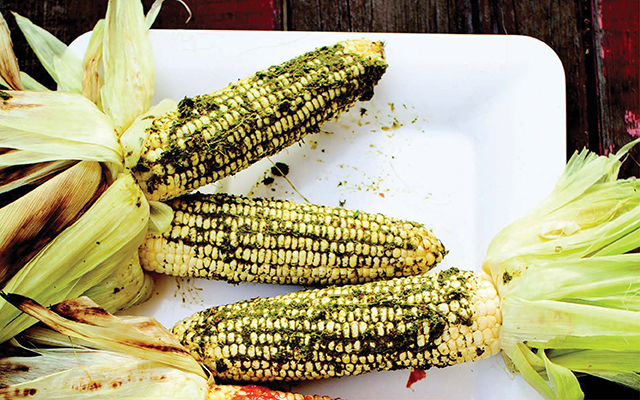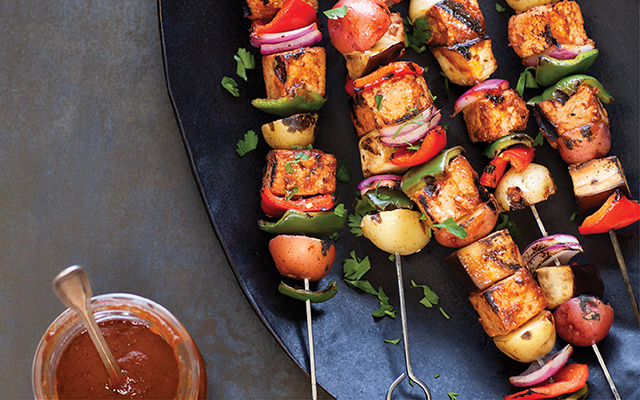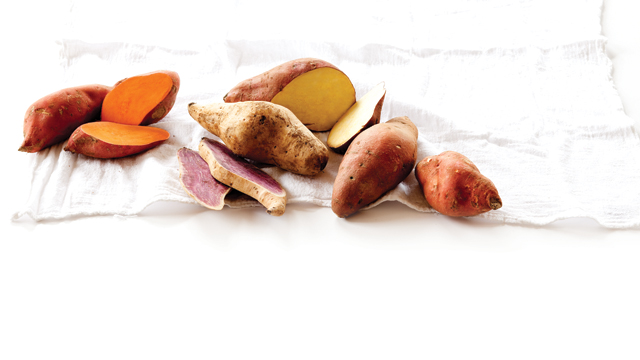When people first begin cooking, they naturally tend to gravitate toward the foods they grew up with — and that’s where I started, too. My grandparents are from rural Mississippi and Tennessee, so I was exposed early on to the flavors of the American South.
Southern foods are rich in influences from West and Central Africa, as well as the Caribbean. The distinctive spices and sauces from these cultures tell a larger story of modern global fusion. And they impart so much flavor that it’s easy to get excited about what you’re making.
Bold flavors are a natural fit for any barbecue fare. But I think it’s great to go big with sauces and spices, especially when you’re trying to incorporate more plant-based foods into your diet. They have distinctive qualities all their own, of course, and are particularly good at making vegetable dishes pop.
The following recipes deliver a combination of flavors that take you on a culinary journey, connecting you with cuisines and cultures around the globe. Try them on your favorite grilled foods — I’ve offered some examples to inspire you — or get creative and experiment with your own dishes.
Recipes
Blackened Seasoning
Blackening is a Cajun technique in which food is coated with a medley of spices and cooked over high heat, usually in a cast-iron skillet or on a grill. To give your food big, complex flavors, toast whole spices, then pulverize them in a mortar or spice grinder. This blackened seasoning pairs well with vegetables like the grilled okra seen here.

Makes 1/3 cup
Prep time: 10 minutes
Ingredients
- 2 tbs. paprika
- 1 tbs. cumin seeds
- 2 tsp. coriander seeds
- 2 tsp. black peppercorns
- 1 1/2 tsp. coarse sea salt
- 1 1/2 tsp. garlic powder
- 1 tsp. white peppercorns
- 1 tsp. onion powder
- 1 tsp. dried thyme
- 1 1/2 tsp. cayenne pepper, or to taste
Directions
- Preheat a skillet over medium heat. Add the cumin and coriander seeds and dry toast them for two to five minutes, shaking the pan often to cook them evenly. Remove from heat and cool.
- Combine the ingredients in a mortar or spice grinder and grind into a fine powder.
- Transfer to a jar and seal tightly. Stored at room temperature, blackened seasoning will keep for six months.
Spicy Mustard-Greens Sauce
Try pairing this sauce with some grilled corn on the cob, or use it as a wonderful spicy condiment for other dishes. I also use it to season couscous and grains by incorporating a few tablespoons before adding water to cook.

Makes 1 cup
Prep time: 15 minutes
Cook time: 20 minutes
Ingredients
- 1 1/4 tsp. coarse sea salt
- 1 cup packed chopped mustard greens
- 3 tbs. extra-virgin olive oil
- 3 cloves garlic, minced
- 1/2 tsp. coriander seeds
- 1/2 tsp. cumin seeds
- 6 tbs. chopped jalapeño chilies
- 1 tsp. smoked paprika
- 1 tsp. red-pepper flakes
- 1/4 tsp. cayenne pepper
- 1 tbs. minced cilantro
- 1 tbs. minced flat-leaf parsley
- 1 tbs. freshly squeezed lemon juice
- 1 tbs. red-wine vinegar
Directions
- Pour about 4 cups of water into a medium saucepan and bring to a boil over high heat. Add 1 teaspoon of the salt, then the mustard greens. Return to a boil and cook uncovered until the greens are wilted, about two minutes. Drain well.
- Warm the oil in a small skillet over low heat. Add the garlic and cook, stirring occasionally, until it starts to turn golden, about five minutes. Transfer the oil and garlic into a small heatproof bowl and set aside to cool.
- In the same skillet, toast the coriander and cumin seeds, shaking the pan occasionally, until fragrant. Let cool for a few minutes, then transfer to a mortar or spice grinder and grind into a fine powder.
- Transfer the powder to a blender. Add the jalapeños, paprika, red-pepper flakes, cayenne, cilantro, parsley, lemon juice, vinegar, cooked mustard greens, garlic oil, the remaining 1/4 teaspoon salt, and 2 teaspoons of water. Purée until smooth. Taste and season with more salt, if desired.
- Use immediately or store in a tightly sealed jar in the refrigerator for up to one week.
Smoky Pili Pili Sauce
African bird’s-eye chilies have grown wild for centuries in Malawi, South Africa, Ghana, Nigeria, Zimbabwe, and Mozambique. They are the main ingredient in this sauce, which is popular throughout Africa. If you can’t find bird’s-eye chilies, you can substitute another pepper, like serrano, which will be milder, or a habanero, which will be hotter. Drizzle this hot sauce over fritters or any other main dish.

Makes 1 cup
Prep time: 15 minutes
Cook time: 35 minutes
Ingredients
- 1 tbs. peanut oil or other high-heat oil
- 1/4 cup finely diced white onion
- 2 tsp. finely grated orange zest
- 2 large cloves garlic, minced
- 1 1/2 tsp. paprika
- 1/2 tsp. coarse sea salt
- 2 to 6 African bird’s-eye chilies, seeded
- 3/4 cup red-wine vinegar
- 2 tbs. freshly squeezed lemon juice
- 1 tsp. bourbon
- 1 tsp. maple syrup
- 1/2 tsp. unsulfured molasses
- 1 tsp. minced fresh basil
- 1/2 tsp. freshly ground white pepper
Directions
- Warm the oil in a small saucepan over medium-low heat. Add the onion and sauté until soft, five to seven minutes.
- Add the orange zest, garlic, paprika, and salt, and sauté until the garlic is fragrant, two to three minutes.
- Transfer the mixture to a blender. Add the chilies, vinegar, lemon juice, bourbon, maple syrup, and molasses, and purée until smooth.
- Pour the mixture back into the saucepan. Partially cover and simmer over low heat, stirring occasionally until the mixture starts to reduce, about 30 minutes. Stir in the basil and white pepper, and simmer for two minutes.
- Use immediately or store in a tightly sealed jar in the refrigerator for up to a week.
Pomegranate-Peach Barbecue Sauce
Although this version is a bit thicker than a typical barbecue sauce from my hometown of Memphis, the important characteristics are all here: It’s tomato based, tangy, and sweet from rich pomegranate molasses and fresh peaches. Enjoy this sauce over grilled or roasted vegetables, or add it to beans or black-eyed peas for a new take on baked beans.

Makes 2 1/2 cups
Prep time: 15 minutes
Cook time: 25 minutes
Ingredients
- 3 tbs. extra-virgin olive oil
- 1/2 cup finely chopped red onion
- 1/4 tsp. coarse sea salt
- 1/8 tsp. cayenne pepper
- 1 large clove garlic, minced
- 1 cup diced peeled peaches
- 1 cup tomato sauce
- 1/4 cup water
- 1/4 cup red-wine vinegar
- 1/4 cup pomegranate molasses (available in most grocery stores)
- 3 tbs. freshly squeezed lime juice
- 2 tbs. tamari
- 2 tsp. tomato paste
- 1 to 3 tbs. chopped chipotle chili in adobo sauce (look in the Hispanic foods section)
- 2 tsp. minced fresh sage
Directions
- Warm the oil in a small saucepan over medium heat. Add the onion, salt, and cayenne; sauté until the onion is soft, five to seven minutes. Add the garlic and sauté until fragrant, two to three minutes.
- Transfer to a blender. Add the peaches, tomato sauce, water, vinegar, pomegranate molasses, lime juice, tamari, tomato paste, and chipotle chili; process until smooth.
- Pour the sauce back into the saucepan and simmer over medium-low heat, stirring occasionally, until thick, about 20 minutes. Stir in the sage and simmer for one to two minutes. Taste and season with more salt, if desired.
- Use immediately or store in a tightly sealed jar in the refrigerator for up to one week.
Excerpted with permission from Afro-Vegan by Bryant Terry, copyright © 2014. Published by Ten Speed Press, a division of Penguin Random House, Inc. Photography © 2014 by Paige Green.
Why No Numbers? Readers sometimes ask us why we don’t publish nutrition information with our recipes. We believe that (barring specific medical advice to the contrary) if you’re eating primarily whole, healthy foods — an array of sustainably raised vegetables, fruits, nuts, seeds, legumes, meats, fish, eggs, whole-kernel grains, and healthy fats and oils — you probably don’t need to stress about the numbers. We prefer to focus on food quality and trust our bodies to tell us what we need. — The Editors
This article originally appeared as “Old Flavors, New Soul” in the July/August 2016 issue of Experience Life.


This Post Has 0 Comments